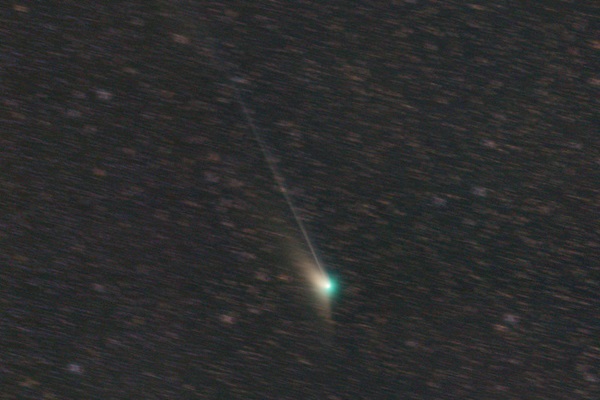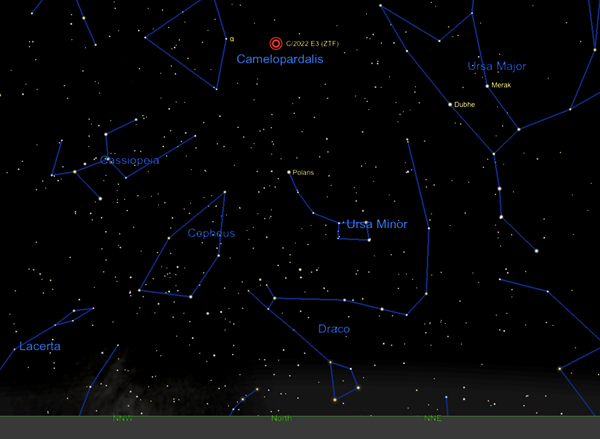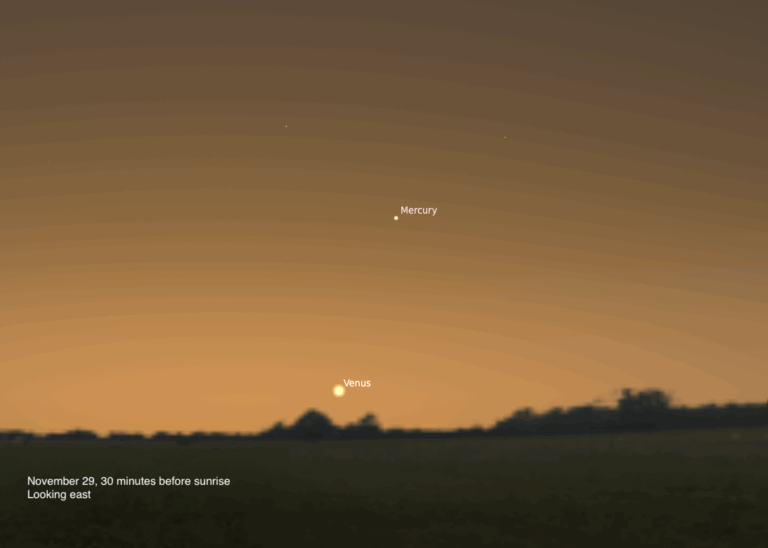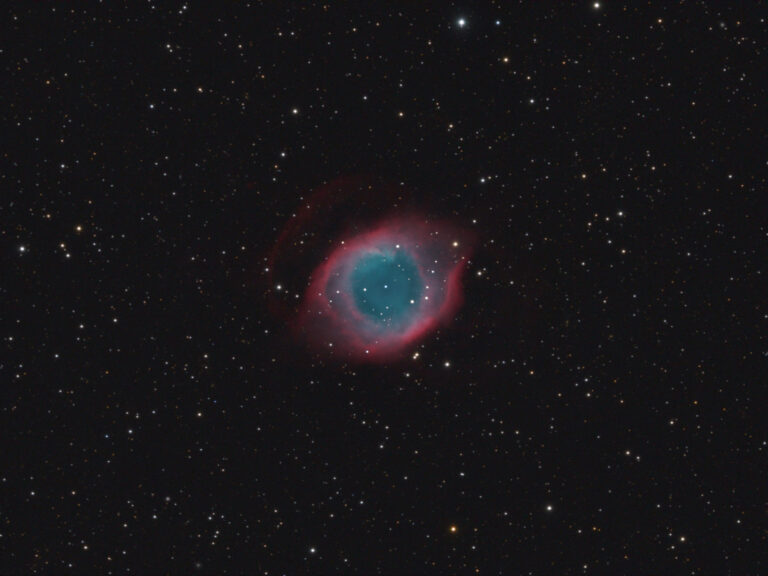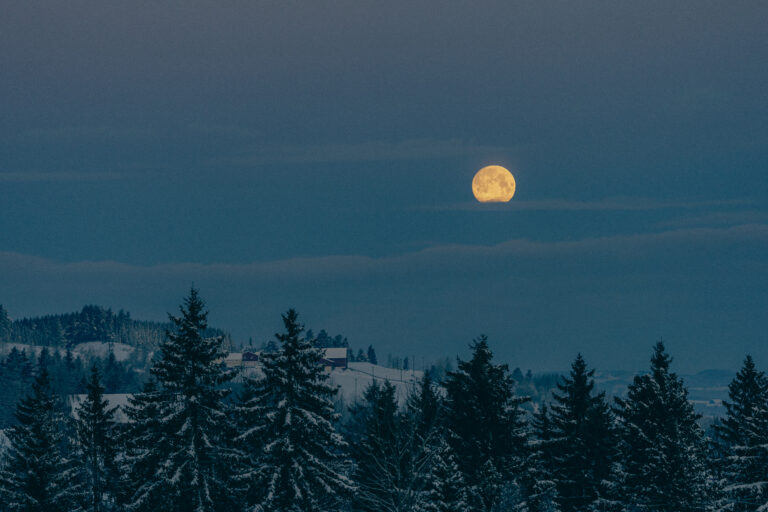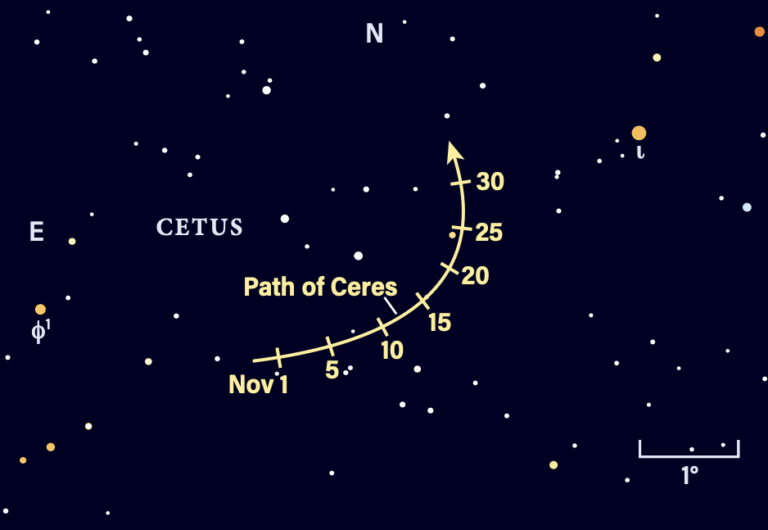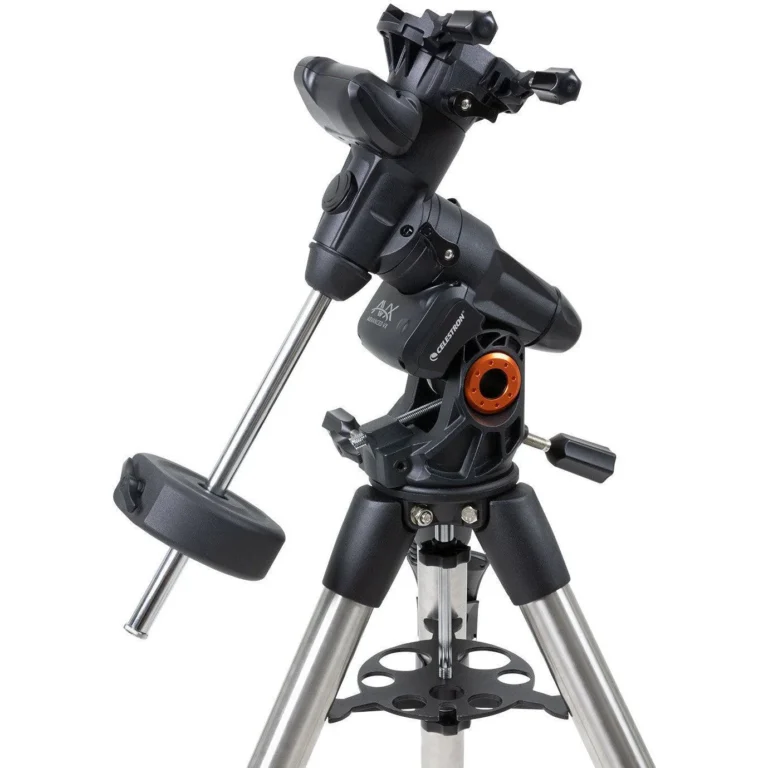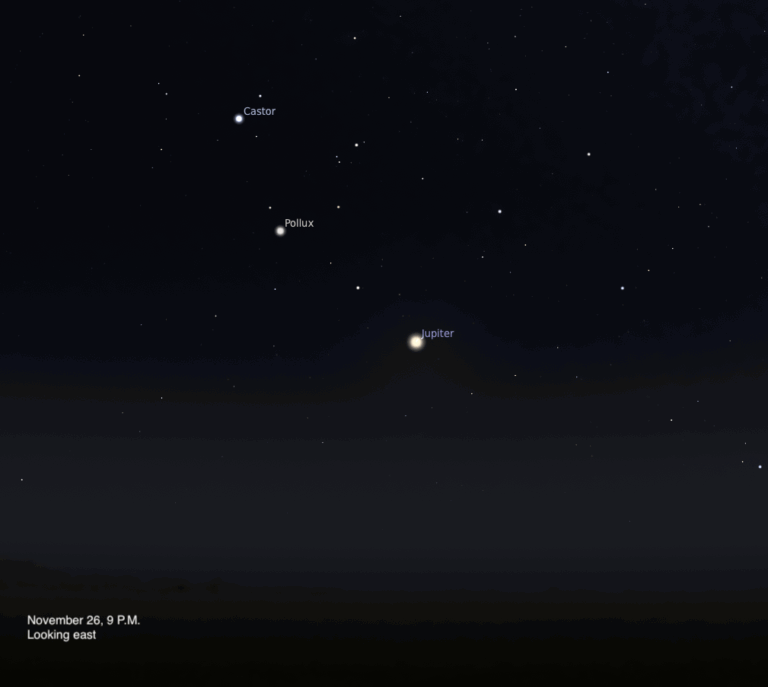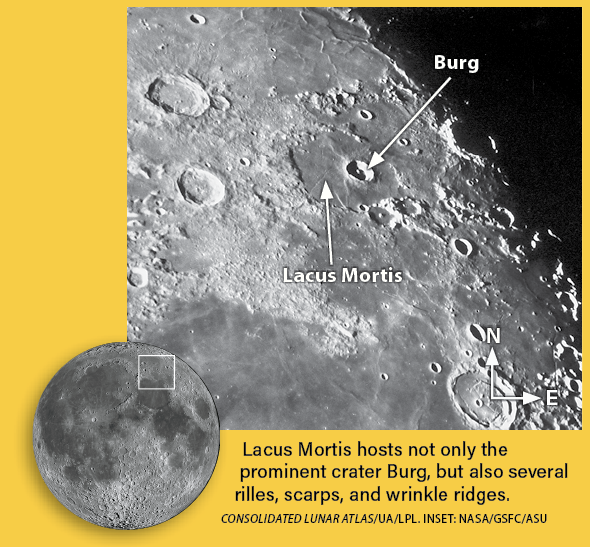Key Takeaways:
Friday, January 27
Cetus the Whale stands above the southwestern horizon these winter nights. This large constellation — the fourth largest of all 88 — covers some 1,231 square degrees and contains several well-known stars.
One such star is Mira, also cataloged as Omicron (ο) Ceti. An aging variable star, Mira changes in brightness between roughly 3rd and 10th magnitude over the course of just under a year (330 days). So, sometimes it is readily visible to the naked eye, taking its proper place in the center of the constellation, and sometimes it appears to have vanished! In fact, Mira’s last peak, when it was brightest, was July last year, and its next is June of this year. So, if you look for it with the naked eye tonight, you won’t see it — it’s simply too faint. But, of course, you can pick it up with binoculars or a telescope, some 12.7° southwest of our next stop: magnitude 2.5 Menkar, Cetus’ alpha star.
Menkar marks the Whale’s head. This star is slightly younger than Mira but is now reaching the later stages of its life, no longer burning hydrogen into helium in its core. Astronomers believe that Menkar, too, will become a variable like Mira, before ultimately ending its life as a white dwarf.
On the other side of the constellation to the southwest, marking the tail of Cetus is Deneb Kaitos (Beta [β] Ceti), also called Diphda. At magnitude 2, it is brighter than Menkar, despite its Greek-letter “rank” of second. This star is relatively close to Earth, just 96 light-years distant, compared with Menkar’s 220. Diphda gives off copious amounts of X-rays and appears to be fusing its helium into carbon as it, too, approaches the later stages of its life.
Sunrise: 7:13 A.M.
Sunset: 5:13 P.M.
Moonrise: 10:42 A.M.
Moonset: —
Moon Phase: Waxing crescent (41%)
*Times for sunrise, sunset, moonrise, and moonset are given in local time from 40° N 90° W. The Moon’s illumination is given at 12 P.M. local time from the same location.
Saturday, January 28
First Quarter Moon occurs at 10:19 A.M. EST. Just over 12 hours later, at 11 P.M. EST, the Moon passes 0.9° north of Uranus.
The pair are in Aries the Ram, which lies in the southwest after dark. This constellation doesn’t have many bright stars: Hamal (magnitude 2) and Sheratan (magnitude 2.6) are the most notable. The Moon sits about 11.5° southeast of these stars, and Luna is now nearly 2° due west of distant Uranus. The planet sits inside a triangle of three of the Ram’s fainter (5th to 6th magnitude) stars: Sigma (σ), Omicron, and Pi (π) Arietis. The half-lit Moon sits just outside the perimeter of this triangle.
You’ll need binoculars or a telescope to view Uranus, which glows softly at magnitude 5.8. It will appear as a dim, “flat”-looking star, whose edges might appear sharply defined, rather than the formless pinprick of light shown off by stars. Uranus’ disk is just 4″ across, thanks to the planet’s distance from Earth: some 19.54 astronomical units (AU; where 1 AU is the average Earth-Sun distance), or 1.8 billion miles (2.9 billion kilometers).
Sunrise: 7:12 A.M.
Sunset: 5:14 P.M.
Moonrise: 11:07 A.M.
Moonset: 12:18 A.M.
Moon Phase: Waxing gibbous (51%)
Sunday, January 29
The large constellation Cygnus is currently soaring through the early-morning sky. While the Moon remains visible at night, let’s check out the Swan about two hours before dawn to explore one of its many gems: the North America Nebula (NGC 7000).
Located near bright Deneb, the Swan’s tail star, this beautiful emission nebula lies about 3° due east of that luminary, making it easy to find. The nebula is also quite large, spanning some 2° by 12/3°. Under dark skies when Cygnus is higher, sharp-eyed observers may even glimpse this object without optical aid. But because Cygnus is still relatively low and the sky will soon be growing lighter, binoculars or a telescope are your best bet for easily finding your target this morning. (Plus, make a note to come back in summer or autumn — then, Cygnus will be high in the nighttime sky and you’ll have a better chance at spotting NGC 7000 with the naked eye).
A mid-sized telescope with a wide-field eyepiece will capture the entire nebula at once, letting you trace its familiar continental shape. The east coast is sharpest, thanks to a dark nebula (LDN 935) situated directly west of NGC 7000. Just west of that dark patch of sky is the smaller HII region IC 5070, also called the Pelican Nebula.
Sunrise: 7:11 A.M.
Sunset: 5:16 P.M.
Moonrise: 11:35 A.M.
Moonset: 1:25 A.M.
Moon Phase: Waxing gibbous (61%)
Monday, January 30
Mercury reaches greatest western elongation (25°) at 1 A.M. EST this morning. Although it was an evening star in early January, by now the solar system’s smallest planet has switched to rising in the southeast about an hour and a half before the Sun. An hour before sunrise, you’ll find Mercury, now magnitude –0.1, about 4° high and climbing.
The planet resides in Sagittarius, whose Teapot asterism is also rising slowly above the horizon. Today, Mercury is just 7′ northeast of 4th-magnitude Omicron Sagittarii in the constellation’s accompanying Teaspoon asterism. The planet appears some 7″ wide through a telescope and is a 63-percent-lit gibbous. Follow it into the morning twilight, but make sure to stop observing with any telescope or binoculars at least several minutes before sunrise from your location (which may differ from the time listed below).
Over in Taurus, the Moon passes 0.1° south of magnitude –0.3 Mars late tonight at 11 P.M. EST. The two merely appear close for those in northern states, but for observers south of about 37° north latitude, the Moon will occult the Red Planet, passing in front of it and blocking it from view.
As with all occultations, the timing will depend heavily on your location and may occur early on the 31st. In Miami, Mars disappears at 12:38 A.M. EST on Tuesday morning, reappearing 49 minutes later. In Dallas, the Red Planet slips behind the Moon at 11:18 P.M. CST and pops back into view shortly after local midnight. In California, the event occurs earlier in the evening, around 8:30 P.M. PST. Check out the International Occultation Timing Association’s webpage on the event for detailed disappearance and reappearance times from your observing site.
We’ll revisit this pair tomorrow evening to explore their surroundings in more detail.
Sunrise: 7:11 A.M.
Sunset: 5:17 P.M.
Moonrise: 12:07 P.M.
Moonset: 2:30 A.M.
Moon Phase: Waxing gibbous (71%)
Tuesday, January 31
The Moon still shares the constellation Taurus with Mars tonight. As evening darkness falls, Taurus is high in the southeast and still climbing, followed by the familiar figure of Orion the Hunter and his two loyal dogs, Canis Major and Minor.
The Moon now sits near Beta Tauri, one of the Bull’s two horns. It is a waxing gibbous with some 80 percent of its face lit, headed for Full phase early next month. Easily visible are several of its large, dark seas (maria), as well as the rugged, bright highlands in the lunar south.
To Luna’s upper right (west) is Mars, still glowing at magnitude –0.3. The Red Planet is now 11″ across, having shrunk significantly following opposition and its closest approach to Earth late last year. Some surface features may still be visible via video capture, however; as the evening progresses, you might see the dark features of Solis Lacus and Mare Sirenum, as well as the mighty Olympus Mons, rotate onto the disk.
Mars it sits roughly halfway between the waxing Moon and the Pleiades cluster further west. The planet is also now nearly 8.5° north of Aldebaran, Taurus’ red giant alpha star. After spending a significant amount of time in Taurus, Mars is now moving east, taking a path that will carry it between Beta and Zeta (ζ) Tauri by early March.
Sunrise: 7:10 A.M.
Sunset: 5:18 P.M.
Moonrise: 12:45 P.M.
Moonset: 3:34 A.M.
Moon Phase: Waxing gibbous (79%)
Wednesday, February 1
Today marks Comet C/2022 E3 (ZTF)’s closest approach to Earth, when it comes within about 0.28 AU— that’s 26 million miles (42 million km) — of our home planet. This is the week you can expect the comet to be at its brightest, zipping along at a pace that covers some 6° of the sky at a time!
ZTF is in Camelopardalis high in the north this evening, sitting about 7.5° east-northeast of the constellation’s magnitude 4.3 alpha star. Although ZTF has been recorded at magnitude 6 (the faintness cutoff for naked-eye visibility) in recent days, you’ll still want to hunt for it with binoculars or a telescope (any size will do). The comet now sports a significant tail and green glow from the dicarbon in its atmosphere — two features that should be easy to pick up in a photograph.
But note that the comet is moving quickly, shifting noticeably in your field of view after just 10 minutes or so. It’s celestial geometry in action as the nearby icy dustball rapidly crosses in front of the much more distant background stars. Photographers will need to use a short exposure time for sharp images.
Barring any unexpected (though pleasant) surprises, this just may be the best comet of the year, and it’s at its brightest. If you can, get out and observe it this week, or follow it as it plunges south, making a pass by Mars as it skims through Taurus around midmonth, though note that it will be fading all along the way.
Sunrise: 7:09 A.M.
Sunset: 5:19 P.M.
Moonrise: 1:30 P.M.
Moonset: 4:33 A.M.
Moon Phase: Waxing gibbous (86%)
Thursday, February 2
Drop south of blazing Sirius this evening to find the main-belt asteroid 2 Pallas hiding underneath the paws of the Big Dog. , a small telescope from the suburbs should pick up Pallas (glowing a soft magnitude 7.7) relatively easily despite the light of the waxing Moon. In fact, Pallas should be relatively simple to identify against the fainter background stars in its immediate vicinity. Only magnitude 4.3 Xi1 (ξ1) is brighter, some 1.7° north-northwest of the asteroid.
From Xi1, turn due northeast and, some 4.2° away, you’ll come upon the open cluster M41, a small grouping of stars that collectively glow about magnitude 4.5. Covering about 38′, look within the cluster’s depths for several red-hued giants.
Pallas will slowly head north, passing due west of M41 around the 15th and then appearing west of the Dog Star itself around the 25th.
Sunrise: 7:08 A.M.
Sunset: 5:20 P.M.
Moonrise: 2:20 P.M.
Moonset: 5:27 A.M.
Moon Phase: Waxing gibbous (92%)
Friday, February 3
Venus and Jupiter rule the evening sky this month, hanging in the west after sunset. An hour after the Sun disappears, Venus is still 10° high, situated near Hydor in Aquarius. The planet is magnitude –3.9, making it the brightest object in the sky after the Moon. To Venus’ upper left, situated in Pisces, is Jupiter. The mighty gas giant is also bright — magnitude –2.2 — and is 35° high at this time.
Note the planets’ positions and keep an eye on them throughout the month: In the coming weeks, Jupiter will sink while Venus climbs, until the two closely mingle in a conjunction two days into March.
Turn your telescope on Venus first to see its 11″-wide, 91-percent-lit disk. That size will increase just slightly even as the gibbous phase wanes throughout February. Jupiter, stretching 36″ across, is accompanied by its four Galilean moons. Early in the evening, Ganymede sits just east of the planet, crossing onto the disk just before 7:40 P.M. EST. It takes nearly two hours to traverse the planet’s face, exiting around 9:30 P.M. CST (after Jupiter has set for East Coast observers). The moon’s shadow, lagging behind, won’t begin to fall across the cloud tops until roughly 9:10 PST — not long before the planet sets. Meanwhile, Io, Europa, and Callisto stretch west of Jupiter, remaining in that order (from nearest to farthest) all evening.
Sunrise: 7:07 A.M.
Sunset: 5:22 P.M.
Moonrise: 3:18 P.M.
Moonset: 6:14 A.M.
Moon Phase: Waxing gibbous (96%)

